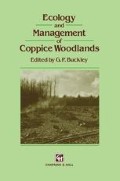Abstract
A few years ago I gave a lecture on coppicing which started as follows:
Coppicing is widely regarded as a conservation panacea resulting in high structural diversity and species diversity but it can also be viewed as producing a dwarf uniform even-aged biologically impoverished nutrient-depleted woodland. Which view is correct?
Access this chapter
Tax calculation will be finalised at checkout
Purchases are for personal use only
Preview
Unable to display preview. Download preview PDF.
References
Ash, J.E. and Barkham, J.P. (1976) Changes and variability in the field layer of a coppiced woodland in Norfolk, England. Journal of Ecology 64, 697–712.
Brown, A.H.F. (1981) The recovery of ground vegetation in coppice wood: the significance of buried seed, in Forest and Woodland Ecology ITE Symposium 8 (eds F.T. Last and A.S. Gardiner), Institute of Terrestrial Ecology, Cambridge, pp. 41–4.
Brown, A.H.F. and Oosterhuis, L. (1981) The role of buried seed in coppiced woods. Biological Conservation 21, 19–38.
Cressy, J. (1987) Ecology and conservation of cow wheat MSc thesis in Conservation, University College London.
Flegg, J.J.M. and Bennett, T.J. (1974) The birds of oak woodlands, in The British Oak: its history and natural history(eds M.G. Morris and F.H. Perring) Botanical Society of the British Isles, E.W. Classey, Faringdon, pp. 324–40.
Ford, E.D. and Newbould, P.J. (1977) The biomass and production of ground vegetation and its relation to tree cover through a deciduous woodland cycle. Journal of Ecology 65, 201–12.
Fuller, R.J., Stuttard, P. and Ray, C.M. (1989) The distribution of breeding songbirds within mixed coppiced woodland in Kent, England, in relation to vegetation age and structure. Annales Zoologicii Fennici 26, 265–75.
Goldsmith, F.B. (1983) Evaluating nature, in Conservation in Perspective(eds A. Warren and F.B. Goldsmith), Wiley, Chichester, pp. 233–46.
Goldsmith, F.B. (1988) Threats to woodland in an urban landscape: a case study in Greater London. Landscape and Urban Planning 16, 221–8.
Goldsmith, F.B. (1991) The selection of protected areas, in The Scientific Management of Temperate Communities for Conservation (eds I. Spellerberg, F.B. Goldsmith and M.G. Morris), Blackwell Scientific, Oxford, pp. 273–91.
Mitchell, P.L. and Kirby, K.J. (1989) Ecological Effects of Forestry Practices in Long-established Woodland and their Implications for Nature Conservation Oxford Forestry Institute Occasional Paper 39, Department of Plant Sciences, University of Oxford.
Peterken, G.F. (1977) Habitat conservation priorities in British and European woodlands. Biological Conservation 11, 223–36.
Peterken, G.F. (1981) Woodland Conservation and Management Chapman and Hall, London.
Rackham, O. (1976) Trees and Woodland in the British Landscape Dent, London.
Ratcliffe, D.A. (1977) A Nature Conservation Review Volume 1, Cambridge University Press, Cambridge.
Salisbury, E.J. (1924) The effects of coppicing as illustrated by the woods of Hertfordshire. Transactions of the Hertfordshire Natural History Society 18, 1–21.
Simms, E. (1971) Woodland BirdsCollins, London.
Sterling, P.H. and Hambler, C. (1988) Coppicing for conservation: do hazel communities benefit? In Woodland Conservation and Research in the Clay Vale of Oxfordshire and Buckinghamshire (eds K.J. Kirby and F.J. Wright) Nature Conservancy Council, Peterborough, pp. 69–80.
Warren, M.S. (1985) The influence of shade on butterfly numbers in woodland rides, with reference to the wood white Leptidea sinapsis Biological Conservation 33, 147–64.
Warren, M.S., Thomas, C.D. and Thomas, J.A. (1984) The status of the heath fritillary butterfly Mellicta athalia Rott., in Britain. Biological Conservation 29 287–305.
Editor information
Editors and Affiliations
Rights and permissions
Copyright information
© 1992 Springer Science+Business Media Dordrecht
About this chapter
Cite this chapter
Goldsmith, F.B. (1992). Coppicing — a conservation panacea?. In: Buckley, G.P. (eds) Ecology and Management of Coppice Woodlands. Springer, Dordrecht. https://doi.org/10.1007/978-94-011-2362-4_16
Download citation
DOI: https://doi.org/10.1007/978-94-011-2362-4_16
Publisher Name: Springer, Dordrecht
Print ISBN: 978-94-010-5042-5
Online ISBN: 978-94-011-2362-4
eBook Packages: Springer Book Archive

